Volkswagen Atlas Cross Sport 2023 Review

2023 Volkswagen Atlas Cross Sport: The Volkswagen Atlas has been one of the brand’s best-selling vehicles since it replaced the expensive Touareg in 2018. Due to its popularity and German automakers’ penchant for “crossover coupes,” the Atlas Cross Sport, a more svelte and fashionable two-row variant of the family-friendly three-row Atlas, was born. Similar to the BMW X6 and the X5, it has a sportier appearance but shares all of the technical components and most configuration possibilities with the three-row variant. But unlike the X6, which sacrifices size, it preserves the spacious rear seat and load compartment of the Atlas.
The 2023 Atlas Cross Sport has numerous variations, including SE, SE with Technology, SEL, SEL R-Line Black, and SEL Premium R-Line. The Buick Envision, Chevrolet Blazer, Hyundai Santa Fe, and Honda Passport are just a few of the family SUVs the Cross Sport goes up against in the marketplace. It lacks the Passport’s trail-friendly features and is less comfortable than Envision or Santa Fe. Nevertheless, it combines high technology and safety equipment and is unquestionably elegant. However, a significant upgrade will soon be available for 2024, which could be worth waiting for.
An available 3.6-liter V6 engine provides 276 horsepower and 266 pound-feet of torque, while the base engine in the lineup is a turbocharged 2.0-liter four-cylinder engine with 235 horsepower and 258 pound-feet of torque. These two powerplant choices are neither compelling nor give this Cross a lot of “sport.” Around town, the four-cylinder performs well, but on the highway, its sparkle disappears. Although the V6 is a little better, it still isn’t a hot rod and consumes a lot of gasoline. The Atlas Cross Sport has a comfortable but unremarkable driving experience.
The Atlas Cross Sport has a great outside, but its inside is considerably more similar to its three-row brother, which is a mixed bag. For the Atlas Cross Sport to seem luxurious, VW used too many harsh plastics, and the cabin finishes the look and feels antiquated. Even so, it’s a pleasant place to spend some time, and the front seats provide a ton of room and comfort. Tall persons have plenty of leg and head space in both rows, and all chair positions have comfortable cushioning and support. Front heated seats are standard, and the synthetic leather feels good.
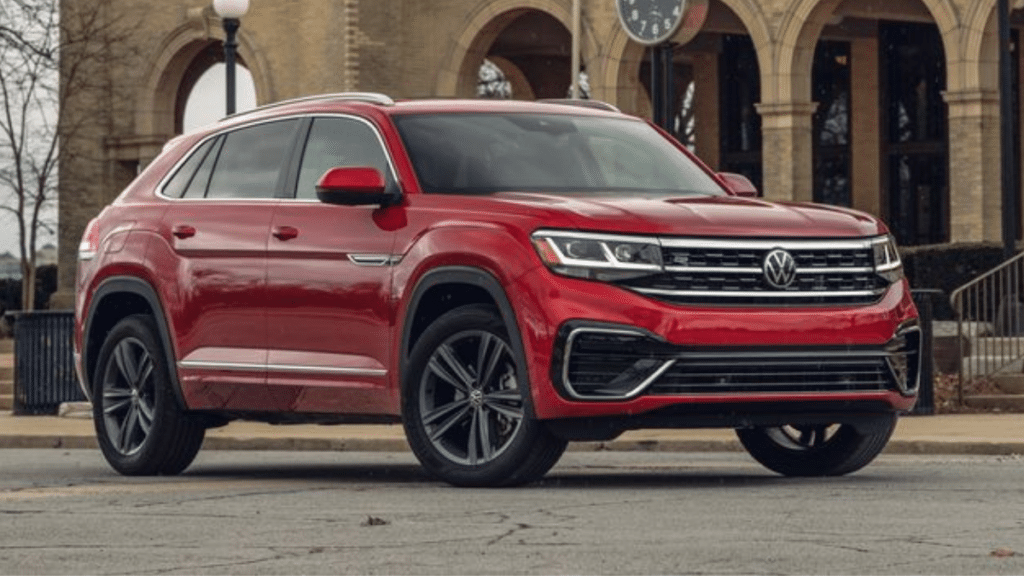
A feature of the three-row Atlas that the Atlas Cross Sport retains is its generous cargo area. The Passport is the only other two-row SUV with more cargo space behind the second row, at 40.3 cubic feet. VW comes standard with a 6.5-inch touchscreen that is too tiny, but it also has Apple CarPlay and Android Auto. Some displays support wireless Apple CarPlay and Android Auto, including an eight-inch monitor and a 10.2-inch digital gauge cluster. Though its technology isn’t as spectacular as others, Volkswagen’s is dependable and straightforward while driving.
Volkswagen also produces a ton of reliable safety equipment. The Atlas Cross Sport likewise emulates BMW, making the finest equipment optional by saving it for higher trims. SEL and the above variants provide a plethora of active safety gear. The SE basic model standardizes blind spot monitoring, rear cross-traffic warnings, and forward automated emergency braking. The Atlas Sport Cross isn’t a horrible deal if the style captures your attention; model-for-model costs a bit less than the three-row Atlas, but it’s still more expensive than competing models from GM or Hyundai.
Performance: Volkswagen Atlas Cross Sport
The oomph required to make the Atlas Cross Sport live up to the “sport” part of its moniker isn’t provided by either engine. The V6 isn’t much quicker than the standard four, but it does have to work a bit less complicated. Both are okay at lower speeds but need too much effort to achieve higher rates, and passing on the highway may seem like a chore. Despite being a welcome difference from the sea of continuously variable transmissions in the area, the eight-speed automatic gearbox may be sluggish to downshift.
At the same time, the SUV generally provides strong traction with the optional 4Motion all-wheel drive (AWD), good handling, and a pleasant ride. The Atlas Cross Sport comes standard with front-wheel drive, while SEL and higher models come standard with 4Motion.
The Atlas Cross Sport seems less eager to perform than competitors like the Passport, Santa Fe, and Blazer, but it competes well with the Buick Envision. Although the Kia Sorento and Santa Fe hybrid variants are also available, the Honda Passport’s base V6 has more than enough power to propel it forward with enthusiasm. The four- or six-cylinder Blazer is the athlete of this group.
The Atlas Cross Sport can tow up to 5,000 pounds when equipped with the VR6 but only 2,000 pounds when equipped with the turbo four.
It’s more than several midsize crossovers, such as the Nissan Murano’s 1,500 pounds and the Chevrolet Blazer’s 1,500 (basic engine) and 4,500 (optional V6), which have lower maximum weight capacities. The Jeep Grand Cherokee ranges from 6,000 to 7,200 (depending on the engine and number of wheels driven), which is still significantly less than this. It’s impressive that the Hyundai Santa Fe and Honda Passport can tow up to 3,500 and 5,000 pounds, respectively.


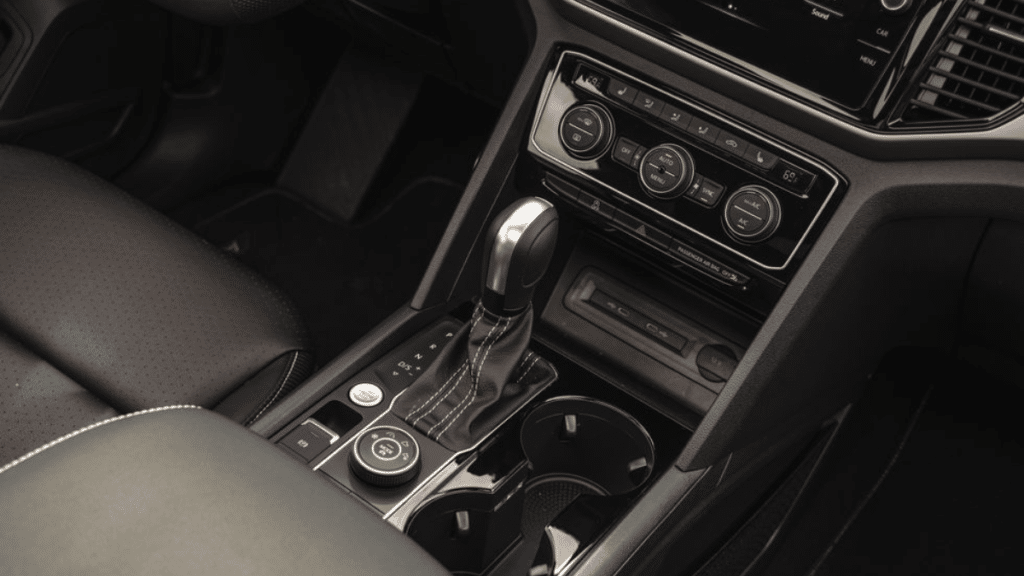
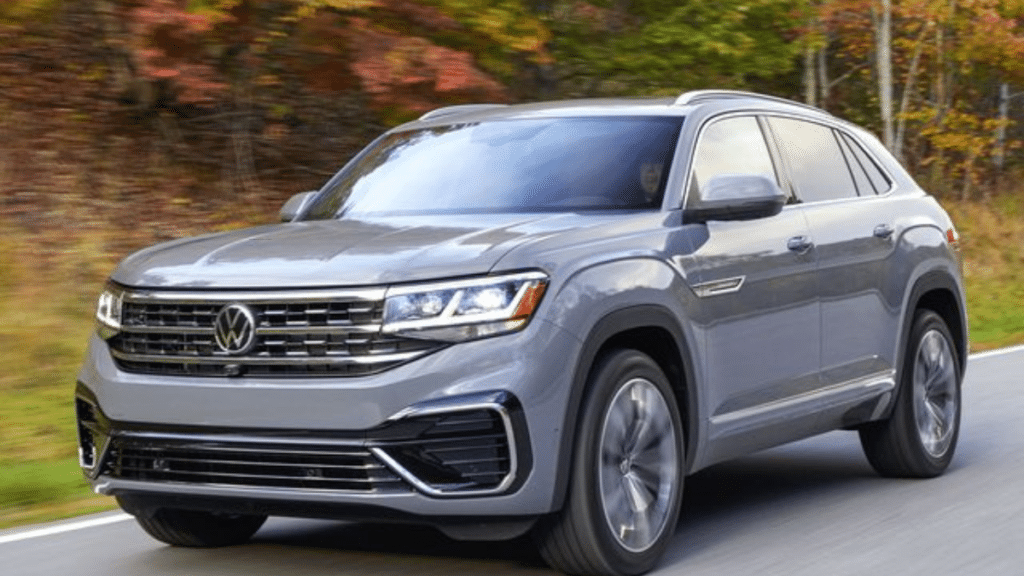
Fuel efficiency: Volkswagen Atlas Cross Sport
The Atlas Cross Sport and three-row Atlas aren’t very fuel efficient, with 4,300 pounds of weight to tote about in a four-cylinder configuration. The Atlas Cross Sport gets 23 mpg combined (21 cities, 25 highways) with front-wheel drive, but it loses one mpg in every category with AWD. With its optional hybrid models, the Santa Fe and Sorento perform much better than the Blazer, Nissan Murano, and Envision, which all have superior average fuel efficiency throughout their lines at 23 mpg. The Envision and (non-plug-in hybrid) Grand Cherokee are nearly on par with the Cross Sport at 21. The Passport will go 24.
Safety & Driver Support
The Insurance Institute for Highway Safety (IIHS) gave the Atlas Cross Sport “Good” ratings across the board in crash tests; however, due to its inconsistent collision prevention ratings, it was not selected as a Top Safety Pick. The National Highway Traffic Safety Administration (NHTSA) rated it five stars.
Automatic emergency braking, frontal collision warnings, and blind spot monitoring with rear cross-traffic alerts are standard equipment; however, other Volkswagen innovations, such as adaptive cruise control with lane keeping, are optional or only available on SEL and above models. Adaptive cruise is available with the SE’s Technology package, but not all of Volkswagen’s IQ—Drive’s other features.
For the side-impact test, the IIHS modified their crash testing guidelines with stricter requirements for 2023. Several previously qualifying automobiles were removed from the Top Safety Pick list due to the change’s increased force. The Kia Sorento and Hyundai Santa Fe received Top Safety Pick honours for outstanding performance in the new testing. In crash tests, the 2023 Passport received a “Marginal” rating for the latest side test, among other outcomes.
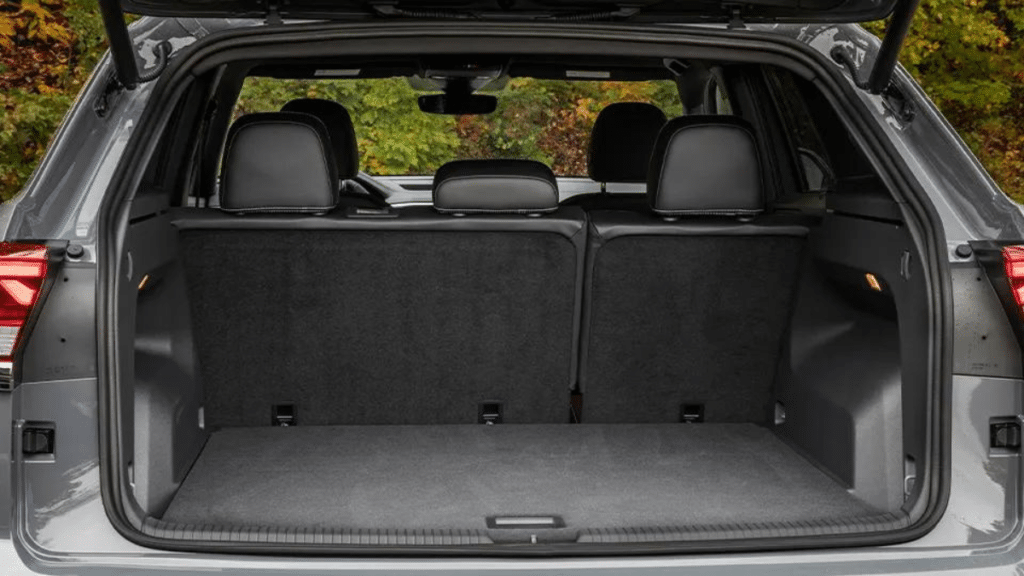
Comfort and Space
The Cross Sport’s two rows are comfortable and roomy despite being one less than the conventional Atlas. The Cross Sport’s second row is noticeably more significant than the Atlas’ second row since there is no need to create a place for the way back. Even though it’s billed as a five-seater, five passengers may travel comfortably. There is also plenty of space for children and child seats.
The bottomless, supporting front buckets provide a superb outward view. The headroom for passengers in the second row is somewhat smaller than in the standard Atlas (37.8 to 40.4 inches), while the legroom is reversed, going from 40.6 inches in the Atlas Cross Sport to 37.6 inches in the three-row Atlas. Only the Hyundai Palisade and Kia Telluride have more. The Cross Sport’s rear seat is more rounded and supportive than its competitors.
Infotainment: Volkswagen Atlas Cross Sport
The Atlas Cross Sport’s 6.5-inch display is severely inadequate compared to its closest competitors. The SE W/Technology and above trims have eight-inch shows, significantly improving the situation, although the primary screen is archaic and will be replaced in 2024. However, Volkswagen’s infotainment system is quick and works effectively on both monitors. The bright, transparent displays and simple UI make driving less distracting.
An 8-inch touchscreen is standard equipment on the Kia and Hyundai vehicles, and its software is even more straightforward to operate than VW’s. The Honda Passport has an eight-inch display and one of the most precise operating systems on the market.
Storage & Cargo Space:
Only the Honda Passport, a comparable two-row vehicle, can equal the Atlas Cross Sport’s 40.3 cubic feet of room when the rear seats are folded down (41.2 cubes). With the seats folded flat, the hold increases to 77.8, just beating out the Passport (77.7), the Sorento (75.5), and the Santa Fe (72.1) but falling far short of the three-row Atlas (96.8). However, the Cross Sport is 5.2 inches more manoeuvrable than the three-row Atlas because it is on the outside shooter.
With a hands-free power liftgate, VW makes accessing the area even simpler. That’s much above average for the sector (the Blazer has just 64.2). Loading and unloading are made simple by the spacious cargo floor and comfortable riding height, which is tall enough to hold heavier objects.
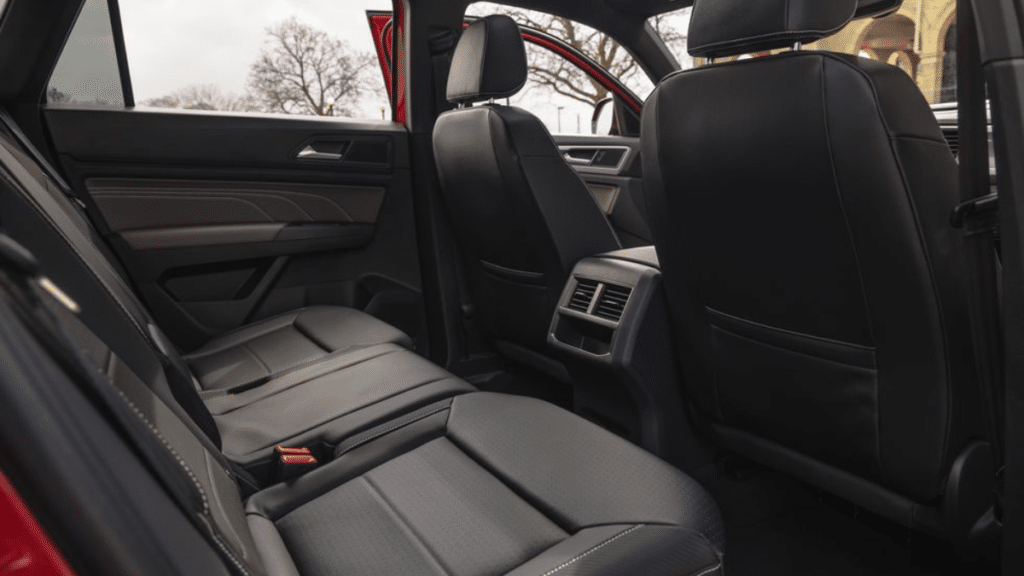


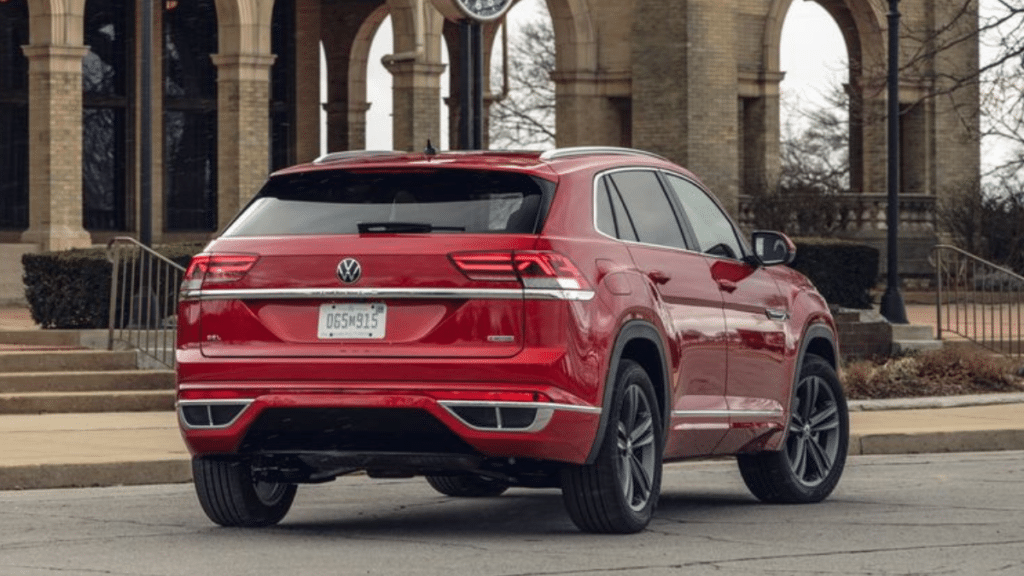
Design: Volkswagen Atlas Cross Sport
The Atlas Cross Sport’s very appealing external styling makes up for its lack of three-row usefulness. A decent-looking three-row SUV might have been awkwardly shortened, but VW got the proportions just right. It has the ideal wheel sizes and posture, giving it a meaty, robust appearance. There is just enough chrome to give it a posh appearance without being garish. The same cannot be said of the inside, which has an outdated style and some cheap-looking materials but is a pleasant location to spend time.
The most recent models of the Hyundai Santa Fe and Kia Sorento are both stylish and contemporary from the inside out, but they don’t have the same impact as the Cross Sport. They adopted the distinctive grilles and lighting features of their respective manufacturers’ iconic front ends. It’s hardly a car people purchase for aesthetics, but the Passport just received a tough Trailsport trim that gives it a more hard-core off-road appearance.
Volkswagen Atlas Cross Sport: Is It Worth It?
There is a growing market of more specialized two-row “tweeners” out there, and the Atlas Sport Cross is one of the most fashionable of them. The majority of midsize popular-brand SUVs are three-row, family-oriented vehicles. Due to its stingy equipment, we’d pass on the basic model SE ($35,755, including a $1,295 delivery charge), but the front-drive SE W/Technology Package ($39,925) strikes a fair balance between features and price.
The intermediate SEL trims have the most outstanding value and features ($45,525 to start, including destination). However, these trims don’t significantly increase the cost. This features improved infotainment systems, the IQ: drive suite, 4Motion AWD, GPS, and automated high beams. The Premium variant of the SEL R-Line adds finer materials and more equipment but costs more than $50,000. There are fancier options with higher performance at that pricing range.

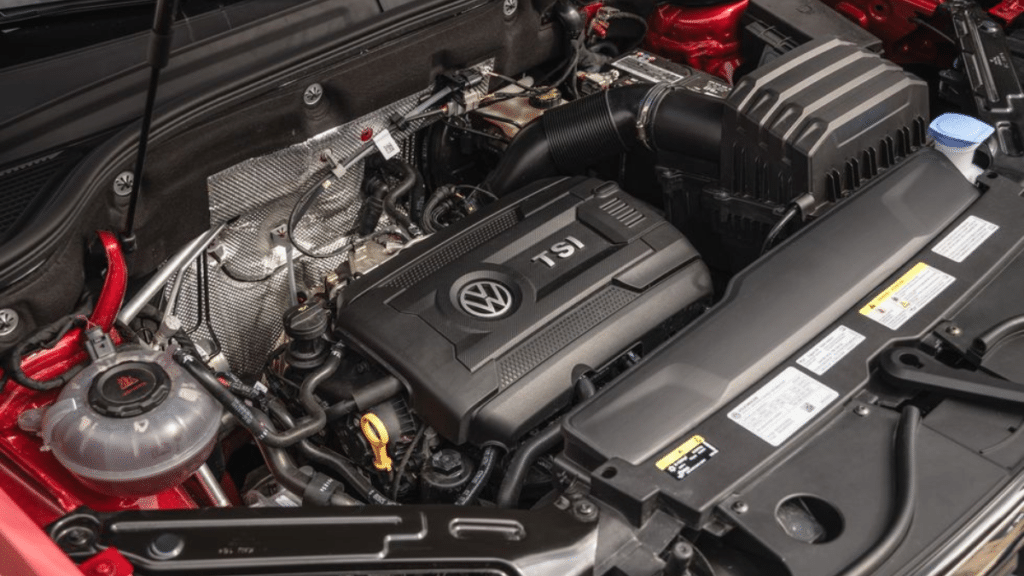


How Much Does the Volkswagen Atlas Cross Sport Cost to Insure?
The Volkswagen Atlas Cross Sport’s insurance rates are comparable or significantly less expensive than its rivals. Although these figures are averages across all 50 states, a typical 30-year-old female driver with a clean record may anticipate an annual premium of $2,115 for an Atlas Cross Sport SEL. Comparatively, a Ford Explorer Timberline costs about $2,121, a Honda Passport costs $1,882, a Nissan Murano costs $2,155, and a Jeep Grand Cherokee Summit costs $2,310.
Verdict
The Volkswagen Atlas Cross Sport, a stylish two-row “crossover coupe” version of the automaker’s three-row Atlas SUV, is undeniably attractive. It excels in luggage and passenger capacity, curb attractiveness, and feature availability, much like its larger sibling. Despite its athletic reputation, life is simple in Cross Sports thanks to the spacious interior and simple controls. Both of its engines lack exciting performance, and the considerable interior is rather underwhelming due to the excessive use of low-quality materials. Fuel efficiency is likewise mediocre since either engine needs to work hard to move this heavy stager around. Volkswagen also reserves the most excellent equipment for the highest trims, increasing costs.
Generations of the Volkswagen Atlas Cross Sport
First Generation
2020 to Present
The Volkswagen Atlas Cross Sport follows the first-generation Volkswagen Atlas three-row SUV in early 2020. The Cross Sport is a scaled-down two-row variant of the standard Atlas, even though it uses Volkswagen’s Modular Transverse Matrix design. The Cross Sport’s appearance is supposed to be reminiscent of “crossover coupes,” such as BMW’s X6, and has a reduced rear overhang and a 2-inch lower roof. However, unlike many of these cars, it does not honestly forgo any luggage or passenger space in favour of aesthetics. However, in exchange for its lead-sled design, it sacrifices around an inch of ground clearance compared to the standard Atlas. A 2.0-litre turbocharged four-cylinder engine or a 3.6-litre VR6 engine, which may be set up with front- or all-wheel drive, provides the power.




